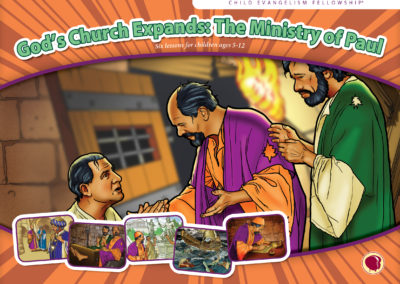Teaching the Divisions of the Bible: Paul’s Letters | Sunday School Solutions
by Aubrey Kyle
Did you have a pen pal growing up? It’s exciting to receive a personal letter in the mail. Maybe some of the children you teach have received or written letters before. The New Testament includes some very special letters, or epistles. We divide these letters into two divisions—Paul’s Letters and Other Letters. Let’s look at Paul’s Letters and how you can teach them to the kids in your Sunday school class!
So far in the New Testament we’ve looked at the Gospel and Church History divisions. We know for sure that Paul wrote at least 13 letters which are now books in the Bible—that’s almost half of the New Testament books! Because we know Paul wrote Romans through Philemon, we included them in the division of Paul’s Letters.
Most of Paul’s letters were written to churches, but the last four were written to individual men. Paul may not have known that the letters he was writing would be saved and read by Christians 2,000 years later, but the Holy Spirit did. Every word in these letters was written at the direction of the Holy Spirit and is just as applicable today as it was 2,000 years ago.
Every word in these letters was written at the direction of the Holy Spirit and is just as applicable today as it was 2,000 years ago.
Paul’s letters are arranged from longest to shortest in our Bibles, and each of these books is named according to the people the letter was written to. To help the children in your class understand which were written to churches and which to individuals, write “Church” and “Person” on the top of a whiteboard or poster board. Write the name of each book under the correct category.
The book of Romans, written to the believers in Rome, presents the Gospel in great detail. It shows how all have sinned, that God has provided a way for us to be justified, and that we can be made righteous through faith by accepting what Jesus did for us through His death and resurrection. Take time to present the Gospel to the children and give those who have never believed in Jesus as their Savior the opportunity to talk with you about that.
Romans teaches how Jesus made the ultimate payment for our sin, and that believers can have victory over sin. Paul encourages us to count on God’s constant care, direction, and perfect love. He ends this letter by challenging believers to give their lives to God completely and explains how a person fully given to God will treat others.
1st Corinthians was written to the Christians in Corinth to help them deal with their many struggles. Paul then wrote 2nd Corinthians with great joy, because the Corinthians had acted upon his first letter! Galatians was written to the Jewish believers to explain that salvation and growth through the Holy Spirit is through Christ alone, not by doing things according to Jewish Law. Ephesians shows God’s design for the Church and how believers have power to live for Him because of Christ’s resurrection.
Several of Paul’s letters were written while he was in jail, including Philippians. Despite the circumstances he was surrounded by, Paul was filled with joy as he wrote. You can use this letter as an example to teach the kids in your Sunday school class how circumstances shouldn’t define their joy but that true joy comes from having a personal friendship with the Lord Jesus.
You can use this letter as an example to teach the kids in your Sunday school class how circumstances shouldn’t define their joy but that true joy comes from having a personal friendship with the Lord Jesus.
Colossians was written to keep believers from turning to false teachings, and 1st and 2nd Thessalonians were written to correct believers understanding about when Jesus will return. 1st and 2nd Timothy, along with Titus, are “pastoral” epistles, written to pastors or people who were leaders in their churches. Finally, in Philemon, we see Paul ask Philemon to forgive his runaway servant Onesimus and take him back, receiving him as a new fellow believer. You can use this book to teach children we should be excited when someone receives Christ, no matter who that person is or how we’ve been treated by them. They should be willing to forgive others like Christ has forgiven us.
For lessons you can use to teach children about Paul and his life, check out God’s Church Expands: The Ministry of Paul lesson series available from CEF Press®. To help the kids in your children’s church learn the order of Paul’s Letters, have them play the game below!
“Mail Mix-Up!”
For this game, you’ll need 13 envelopes and 13 index cards. Label the envelopes 1 through 13. Then, write the name of one of Paul’s letters on each index card until you have a card for each book. Randomly place the index cards inside the envelopes and have the children in your Sunday school class work together to place the cards in their correct envelopes, so they match the order found in the Bible. For some friendly competition, make a second set of envelopes and index cards and divide the kids into teams to race each other and see who can correctly rearrange the cards into the envelopes the quickest!
Each of Paul’s letters has many things to teach us, and this brief summary doesn’t even scratch the surface! Be sure to read and study Paul’s letters yourself so you can more effectively teach them to the kids in your children’s church. Also be sure to join us next time as we look at the Other Letters division of the New Testament!
